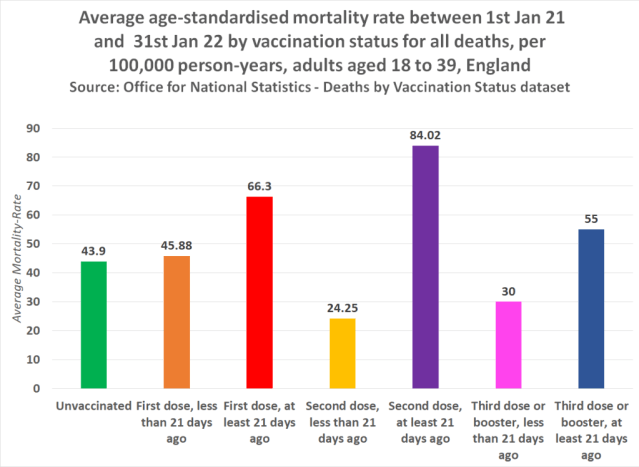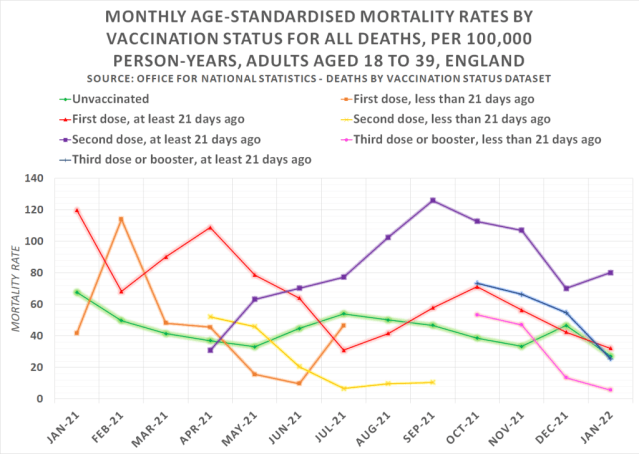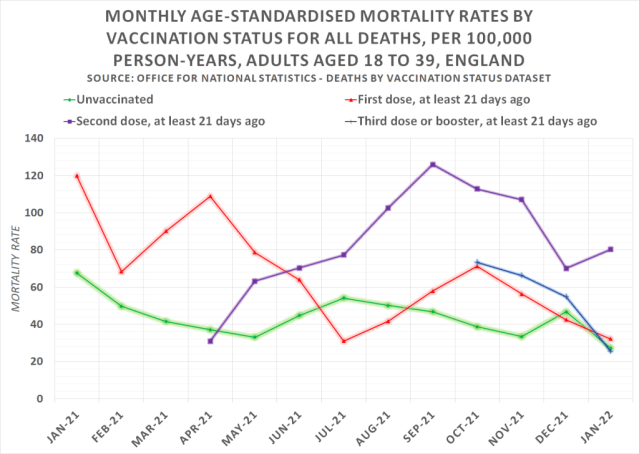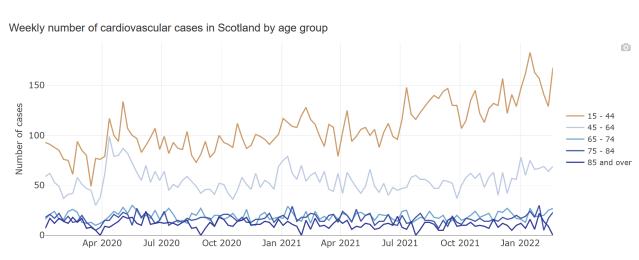Official Government Reports prove COVID Vaccine is to blame for frightening rise in cases of ‘Sudden Adult Death Syndrome’
Doctors are allegedly baffled at what is causing a sudden uptick in what they have dubbed ‘Sudden Adult Death Syndrome’ among adults under the age of 40 over the past year, and are now urging all under 40’s to go and get their heart checked.
But these doctors need not remain “baffled” any longer because we have rock-solid evidence that the Covid-19 vaccine is to blame.
- Official UK Office for National Statistics data shows vaccinated adults aged 18 to 39 have a 92% higher mortality rate (per 100,000) than unvaccinated adults.
- Official Public Health Scotland data reveals there has been a 67% increase compared to the historical average in the number of 15 to 44-year-olds suffering heart attacks, cardiac arrest, myocarditis, stroke, and other cardiovascular diseases since this age group was first offered the Covid-19 injection.
- And figures published by NHS England in response to a freedom of information request show that ambulance call-outs for heart illness have doubled among all age groups including the under 30’s since the beginning of the Covid-19 vaccination campaign.
Healthy young people are dying suddenly and unexpectedly from what doctors are dubbing “a mysterious syndrome” and these same doctors are now seeking answers through a new national register.
People aged under 40 are now being urged to have their hearts checked because doctors claim they may potentially be at risk of Sudden Adult Death Syndrome.
Doctors say the syndrome, known as SADS, has been fatal for all kinds of people regardless of whether they maintain a fit and healthy lifestyle.
“SADS is an umbrella term to describe unexpected deaths in young people”, said The Royal Australian College of General Practitioners.
But it turns out the term is actually used when a post-mortem cannot find an obvious cause of death, and the reason doctors are struggling to find an obvious cause of death is that we’re now seeing thousands of deaths due to something that was impossible to occur prior to 2021. Covid-19 vaccination.
This becomes obvious once you know where to look. But the problem is doctors are actively discouraged from looking and it is not publicised in the mainstream media. However, all the answers doctors are looking for to explain what they are dubbing Sudden Adult Death Syndrome, are contained in official Government data.
Vaccinated Young Adults have a 92% higher mortality rate (per 100,000) than Unvaccinated Young Adults
The Office for National Statistics (ONS) is the UK’s largest independent producer of official statistics and the recognised national statistical institute of the UK. It is responsible for collecting and publishing statistics related to the economy, population and society at national, regional and local levels.
An ONS dataset on deaths in England by vaccination status can be found here. It contains a large amount of data on age-standardised mortality rates for deaths by vaccination status between 1 January 2021 and 31 January 2022.
Table 2 of the dataset contains data on the monthly age-standardised mortality rates by vaccination status by age group for all deaths in England. The following table shows an example of how the numbers are presented in the dataset –
What immediately catches the eye when looking at this data is the mortality rate per 100,00 person-years among 18-39-year-olds in the month of January 2021. The figures show the death rate among the unvaccinated in this month was 67.7 deaths per 100,000 person-years. Whilst the death rate among the partly vaccinated (at least 21 days ago) was 119.9 deaths per 100,000 years.
This shows that vaccinated 18-39-year-olds were more likely to die in January 2021, suggesting the Covid-19 injections increased the risk of death or played a part in causing death. So we dug further and extracted all the figures on 18-39-year-olds for each month between January 2021 and January 2022, and this is what we found –
The above chart shows the monthly age-standardised mortality rates by vaccination status for all-cause deaths, per 100,000 person-years among adults aged 18 to 39 in England. The green line is the mortality rate among the unvaccinated, which while fluctuating has remained pretty stable throughout.
The other lines however represent different vaccination statuses, and they are extremely concerning. The orange, yellow, and pink lines represent mortality rates within 21 days of receiving a first, second or third dose. And they reveal that the risk of death increases significantly immediately after vaccination.
But the most concerning figures are the mortality rates among those vaccinated at least 21 days ago, which you can see more clearly in the following chart –
What’s most concerning here is that the second injection seems to make things much worse in terms of the risk of death.
The highest mortality rate among the double vaccinated (at least 21 days ago) occurred in September 2021, with 125.9 deaths per 100,000 person-years. In the same month, the mortality rate among the unvaccinated equated to 46.8. Meaning the double vaccinated mortality rate was 169% higher than the unvaccinated mortality rate.
But the largest statistical difference occurred in November 2021. The mortality rate among the unvaccinated equated to 33.4 deaths per 100,000 person-years, whereas the mortality rate among the double vaccinated equated to 107. A difference of 220.4%.
The following chart shows the average-age standardised mortality rate to have occurred between 1st Jan 21 and 31st Jan 22 by vaccination status for all-cause deaths, per 100,000 person-years among adults aged 18 to 39 in England –
On average the one-dose vaccinated were 51% more likely to die than the unvaccinated between 1st Jan 21 and 31st Jan 22. Whilst the double vaccinated were 91.4% more likely to die than the unvaccinated between 1st Jan 21 and 31st Jan 22. And based on the small amount of data available so far, on average the triple vaccinated are on average 25.3% more likely to die than the unvaccinated.
What these official figures from the UK’s Office for National Statistics strongly suggest is that Covid-19 vaccination kills and increases a person’s risk of death due to any cause. And this increased risk of death isn’t because so many people have been vaccinated, these are figures per 100,000.
Any doctor worth their salt would not instantly use the above to claim that Covid-19 vaccination is the cause of a sudden uptick in Sudden Adult Death Syndrome. They would instead decide that the above warrants further research. So we’ve done that research for them.
Public Health Scotland data reveals a 67% increase in the number of Young Adults suffering heart attacks
Public Health Scotland (PHS) has a not very well known database presenting figures on the wider impact to the health service due to measures imposed in the name of Covid-19. The database is called ‘COVID-19 wider impacts on the health care system‘.
We analysed the data for cardiovascular cases across Scotland. Cardiovascular diseases are conditions that affect the structures or function of your heart, such as:
For the ‘out of hours’ category, and the ‘ambulance service’ category, PHS provides a breakdown by age. Meaning we can assess the number of cardiovascular cases among adults aged 15 to 44.
Here is how Public Health Scotland presents the data on the number of cases requiring out-of-hours care across Scotland –
We extracted the data and produced a series of charts in order to present the figures provided by Public Health Scotland much more clearly and to attempt to understand the severity of what has been occurring since the introduction of the Covid-19 injections.
The following chart shows the number of people aged 15-44 requiring out-of-hours treatment for cardiovascular cases per week from the week ending 4th July 2021 to the week ending 20th Feb 2022, as well as the 2018-2019 historical average per week among the same age group –

The historical average shows that there have been anywhere from around 60 to just over 100 cardiovascular cases among 15 to 44-year-olds requiring out-of-hours treatment across Scotland. But the data for 2021 and 2022 shows that there have been anywhere from around 110 cases to 185 cardiovascular cases among 15 to 44-year-olds requiring out-of-hours treatment.
So the number of cases have essentially doubled.
The following chart shows the number of people aged 15-44 requiring an ambulance for cardiovascular cases per week from the week ending 4th July 2021 to the week ending 21st November 2021 (the most up to date data), as well as the 2018-2019 historical average per week among the same age group –

The historical average shows that there have been anywhere from around 185 to just over 250 people aged 15-44 requiring an ambulance for cardiovascular cases per week across Scotland. But the data for 2021 and 2022 shows that there have been anywhere from around 290 cases to 390 people aged 15-44 requiring an ambulance for cardiovascular cases per week.
So cases haven’t quite doubled but they’ve still increased quite dramatically.
The following chart shows the percentage change in the number of people aged 15-44 requiring out-of-hours treatment for cardiovascular cases per week from the week ending 4th July 2021 to the week ending 20th Feb 2022, compared to the 2018-2019 historical average per week among the same age group –
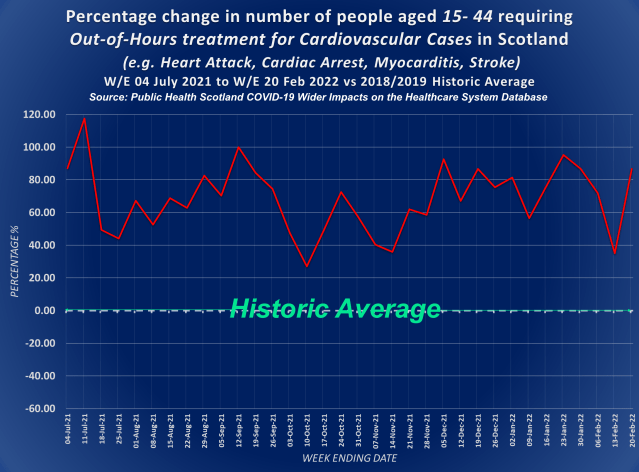
Here we can see that the number of cases requiring out-of-hours care has been higher throughout this entire period, ranging from a 35% increase in a single week to a staggering 117% increase in a single week compared to the historical average.
The following chart shows the percentage change in the number of people aged 15-44 requiring an ambulance for cardiovascular cases per week from the week ending 4th July 2021 to the week ending 21st November 2021, compared to the historical 2018-2019 average per week among the same age group –
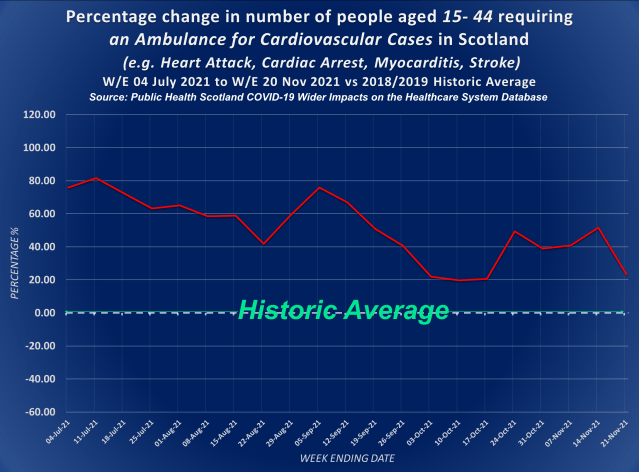
Again we can see that the number of 15 to 44-year-olds requiring an ambulance has been higher than the historical average throughout the entire period, ranging from a 23% increase in a single week to an 82% increase compared to the historical average.
So now we have two pieces of evidence that suggest Covid-19 vaccination is to blame for the sudden uptick in Sudden Adult Death Syndrome. Any doctor who became aware of this would now surely be extremely concerned. But if the above isn’t enough to convince them then perhaps this third piece of evidence from NHS England is.
Ambulance call-outs for Heart illness have Doubled since the beginning of the Covid-19 Vaccination Campaign
The National Health Service has confirmed in response to a freedom of information request that ambulance call-outs relating to immediate care required for a debilitating condition affecting the heart nearly doubled in the whole of 2021 and are still on the rise further in 2022. But the most concerning published figures show that they have also doubled among people under the age of 30.
On the 25th April 2022, Duncan Husband sent a Freedom of Information (FOI) request to the West Midlands Ambulance Service University NHS Foundation trust requesting to know the following –
The NHS responded on the 18th May with a spreadsheet containing the requested information. The following charts visualise the data contained in that spreadsheet –
As we can see from the above two charts, ambulance call-ours for high conditions have been higher overall since January 2021, and have been increasing month on month. It was not until April 2021 that we saw a significant increase among people under the age of 30 though, and it again has increased month on month since then.
The following chart shows the overall total call-outs by year for everyone and those aged 0 to 29 –
The following chart shows the monthly average number of ambulance call-outs for conditions relating to the heart by year –
There was a significant increase in 2021 among all age groups, and unfortunately, things got even worse in the first few months of 2022.
Healthy young people are dying suddenly and unexpectedly from what doctors are dubbing “a mysterious syndrome” and these same doctors are now seeking answers through a new national register. But they need not call it “a mysterious syndrome” anymore because we have just proven the Covid-19 vaccine is to blame.

